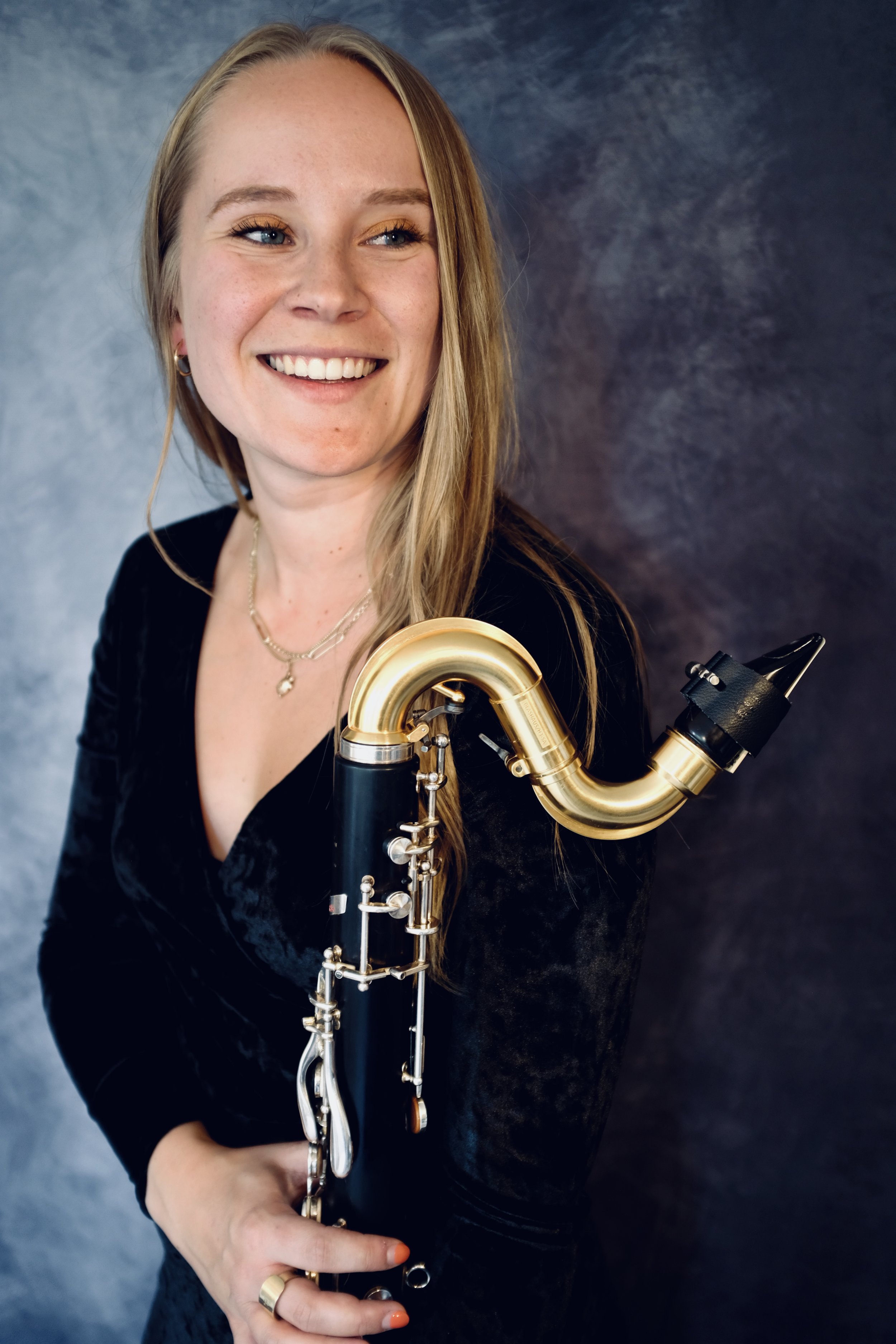Hannah's Hidden Gems of the Orchestra
In June, we were lucky to have bassoonist Daria Phillips join us for our Secret Concert series. This the first time we have ever showcased a bassoon at DEBUT, and it’s made us realise how little is known about some hidden gems found in the orchestra.
Our Head of Marketing Hannah Shilvock is a bass clarinet specialist. Here’s her low-down on the other hidden gems you need to know about!
Photo by Olivia Da Costa
Cor Anglais
The big brother of the oboe, from the double reed family of woodwind instruments (same as the bassoon!).
The Cor Anglais (aka. the English horn) is a beautiful, underrated instrument that can be found in the orchestra. It, like the bassoon, is infrequently heard in solo contexts - but can make a powerful solo instrument.
Approximately one and a half times the size of the oboe, and is therefore able to play lower than the oboe, and has a darker, more mellow timbre. The Cor Anglais can achieve an incredibly expressive sound, and is often used for slow, emotional melodies within orchestral pieces.
Meet Catherine Underhill, a freelance oboist and cor anglais specialist.
Catherine’s fun facts
The bell of the cor anglais is shaped like an onion (a way it looks different to the oboe!).
It’s in the key of F!
Why do you love the Cor Anglais so much?
The cor anglais has such a dark and rich tone, so versatile and it gets so many beautiful solos. There’s less solo repertoire written for the instrument, so I’m currently working on getting more music written for my duo - Hacha Duo.
Catherine’s listening picks
Bellini - A Pasculli Omaggio (cor anglais and harp)
Sibelius - The Swan of Tuonela
French Horn
The Horn is one of the most ancient instruments. The French Horn made its debut in a ballet in Paris in 1664. The French Horn has an extremely rich and soft timbre - played well, it can sound truly magical - and in my opinion, is totally underrated!
Meet Benjamin Garalnick, an energetic and engaging Horn player living in London - teaching, freelancing & playing in Chineke!
Ben’s fun facts
As a horn player you are expected to be able to transpose - in Verdi’s Requiem you have to jump between French Horn in A, D, Bb and so on… you have to be able to transpose the notes as you read them (on the fly!)
You can easily make your own French Horn at home - with a Horn mouthpiece, 12 foot of garden hose and a funnel (duck taped onto the end)!
Why do you love the French Horn so much?
I love it because all of the technical things that go into Horn playing are so abstract - from embouchure to hand position, to transposition. But when you put all of this together, you can achieve one of the most beautiful sounds discovered.
Ben’s listening picks
Weber - Horn Concertino
Dvorak Cello Concerto (horn solo)
Photo by Marc Aldridge
Bass Clarinet
The rock-star of the clarinet family, the bass clarinet can be found in the back row of the orchestral woodwind section, often doubling the bassoon and cello lines. When not doubling other instruments, the bass clarinet has some of the juiciest orchestral solos!
The bass clarinet has one of the largest ranges of all woodwind instruments due to the length of the tube!
Our Head of Marketing Hannah Shilvock is a bass clarinet specialist.
Hannah’s fun facts
You may not be able to name any songs that use the bass clarinet off the top of your head… but it famously features in the Beatles - When I’m 64!
In 1846 Belgian inventor (Adolphe Sax) was trying to improve the tone of the very early bass clarinet… and ended up inventing the saxophone in the process!
Why do you love the bass clarinet so much?
The sound world available to you when you play the bass clarinet is incredibly diverse. Soaring, lyrical, sweet high notes and beefy, punchy low notes. Extended techniques - multiphonics & slap-tonguing to name a few - mean that the sound possibilities are endless!
When you’re playing the low end of the instrument, the vibrations get sent through your body - the instrument really does become an extension of your body. It’s an amazing feeling!
Hannah’s listening picks
Sebastián Tozzola - 7 Pasos
Tchaikovsky - Nutcracker
Percussion
Percussion holds a huge part within the orchestra - but is often overlooked by the audience. Sometimes the percussion is the cherry on top with very sweet triangle notes, and sometimes it is the driving force to get the whole orchestra dancing!
Meet Gosia Kepa - a London based percussionist and marimba specialist.
Gosia’s fun facts
Anything can be a percussion instrument.
We are asked to play timpani, toms, cymbals and xylophones as well as buckets, pistols and our bodies!
Percussion is the oldest group of instruments and originates from multiple different backgrounds. However, one of my favourites - the marimba - in the shape we know today is only 38 years old!
Why do you love percussion so much?
I love percussion because of the available colours. I will never tire of the variety of sounds and how we can produce them.
I specialise in marimba, which is not an orchestral instrument (although, it’s making an appearance every now and then!). The sound of the marimba (especially the low octave) reverberates through your entire body.
Gosia’s listening picks
Stravinsky - Rite of Spring (timpani & bass drum solo)
Fertility Rites by Christos Hatsiz (contemporary marimba)







Experience DEBUT's flagship secret concert at the magical Shoreditch Treehouse, a hidden gem nestled in the heart of Shoreditch, with a Steinway Concert Grand piano under a canopy of twinkling fairy lights.
MUSICIANS
Felicity Buckland mezzo soprano
Mebrakh Haughton-Johnson clarinet
George Ireland collaborative piano
Lizzie Holmes soprano, host & founder
Sam Peña resident pianist & improvisor
Book tickets →